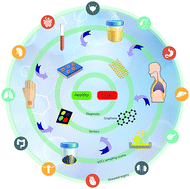当前位置:
X-MOL 学术
›
Chem. Soc. Rev.
›
论文详情
Our official English website, www.x-mol.net, welcomes your feedback! (Note: you will need to create a separate account there.)
Synergy between nanomaterials and volatile organic compounds for non-invasive medical evaluation†
Chemical Society Reviews ( IF 46.2 ) Pub Date : 2018-06-11 00:00:00 , DOI: 10.1039/c8cs00317c Yoav Y. Broza 1, 2, 3, 4 , Rotem Vishinkin 1, 2, 3, 4 , Orna Barash 1, 2, 3, 4 , Morad K. Nakhleh 5, 6, 7, 8, 9 , Hossam Haick 1, 2, 3, 4
Chemical Society Reviews ( IF 46.2 ) Pub Date : 2018-06-11 00:00:00 , DOI: 10.1039/c8cs00317c Yoav Y. Broza 1, 2, 3, 4 , Rotem Vishinkin 1, 2, 3, 4 , Orna Barash 1, 2, 3, 4 , Morad K. Nakhleh 5, 6, 7, 8, 9 , Hossam Haick 1, 2, 3, 4
Affiliation

|
This article is an overview of the present and ongoing developments in the field of nanomaterial-based sensors for enabling fast, relatively inexpensive and minimally (or non-) invasive diagnostics of health conditions with follow-up by detecting volatile organic compounds (VOCs) excreted from one or combination of human body fluids and tissues (e.g., blood, urine, breath, skin). Part of the review provides a didactic examination of the concepts and approaches related to emerging sensing materials and transduction techniques linked with the VOC-based non-invasive medical evaluations. We also present and discuss diverse characteristics of these innovative sensors, such as their mode of operation, sensitivity, selectivity and response time, as well as the major approaches proposed for enhancing their ability as hybrid sensors to afford multidimensional sensing and information-based sensing. The other parts of the review give an updated compilation of the past and currently available VOC-based sensors for disease diagnostics. This compilation summarizes all VOCs identified in relation to sickness and sampling origin that links these data with advanced nanomaterial-based sensing technologies. Both strength and pitfalls are discussed and criticized, particularly from the perspective of the information and communication era. Further ideas regarding improvement of sensors, sensor arrays, sensing devices and the proposed workflow are also included.
中文翻译:

纳米材料与挥发性有机化合物之间的协同作用,可用于非侵入性医学评估†
本文概述了基于纳米材料的传感器领域的当前和正在进行中的发展,这些传感器可以通过检测排出的挥发性有机化合物(VOC)来进行快速,相对便宜和最小程度(或非侵入性)的健康状况诊断,并进行后续跟踪来自人体液体和组织中的一种或多种(例如,血液,尿液,呼吸,皮肤)。审查的一部分对与新兴的传感材料和转导技术相关的概念和方法进行了教学检查,这些材料和转导技术与基于VOC的非侵入性医学评估相关。我们还将介绍和讨论这些创新传感器的各种特性,例如它们的操作模式,灵敏度,选择性和响应时间,以及为增强其作为混合传感器提供多维感测和基于信息的感测能力而提出的主要方法。审查的其他部分提供了用于疾病诊断的过去和当前可用的基于VOC的传感器的最新汇编。该汇编总结了与疾病和抽样来源相关的所有挥发性有机化合物,这些挥发性有机化合物将这些数据与先进的基于纳米材料的传感技术联系在一起。特别是从信息和通信时代的角度来讨论和批评力量和陷阱。还包括关于传感器,传感器阵列,感测设备和所提出的工作流程的改进的进一步构想。
更新日期:2018-06-11
中文翻译:

纳米材料与挥发性有机化合物之间的协同作用,可用于非侵入性医学评估†
本文概述了基于纳米材料的传感器领域的当前和正在进行中的发展,这些传感器可以通过检测排出的挥发性有机化合物(VOC)来进行快速,相对便宜和最小程度(或非侵入性)的健康状况诊断,并进行后续跟踪来自人体液体和组织中的一种或多种(例如,血液,尿液,呼吸,皮肤)。审查的一部分对与新兴的传感材料和转导技术相关的概念和方法进行了教学检查,这些材料和转导技术与基于VOC的非侵入性医学评估相关。我们还将介绍和讨论这些创新传感器的各种特性,例如它们的操作模式,灵敏度,选择性和响应时间,以及为增强其作为混合传感器提供多维感测和基于信息的感测能力而提出的主要方法。审查的其他部分提供了用于疾病诊断的过去和当前可用的基于VOC的传感器的最新汇编。该汇编总结了与疾病和抽样来源相关的所有挥发性有机化合物,这些挥发性有机化合物将这些数据与先进的基于纳米材料的传感技术联系在一起。特别是从信息和通信时代的角度来讨论和批评力量和陷阱。还包括关于传感器,传感器阵列,感测设备和所提出的工作流程的改进的进一步构想。



























 京公网安备 11010802027423号
京公网安备 11010802027423号